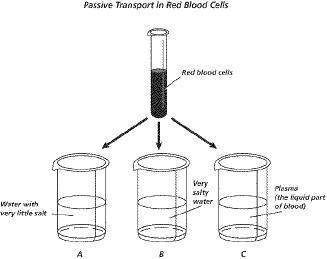
Physics, 04.11.2019 08:31 clairajogriggsk
100 points, brainliest, and free points if you answer all correctly
1.use the diagram to answer the question.
what would happen if some of the red blood cells were placed in beaker b?
water would move into the cells by osmosis, causing the cells to shrink.
water would move out of the cells by osmosis, causing the cells to shrink.
water would move into the cells by osmosis, causing the cells to swell.
water would move out of the cells by osmosis, causing the cells to swell
2.
use the diagram to answer the question.
what would happen if some of the red blood cells were placed in beaker a?
water would move into the cells by osmosis, and the cells would swell.
water would move out of the cells by diffusion, and the cells would shrink.
water would move out of the cells by osmosis, and the cells would shrink.
water would move into the cells by diffusion, and the cells would swell.
3.
what would occur if some of the red blood cells were placed in beaker c? recall that red blood cells normally float in plasma.
the concentration of water inside and outside the cells would be equal, so no osmosis would occur.
the concentration of water inside and outside the cells would be equal, so no diffusion would occur.
the concentration of water inside the cells would be less than outside, so the cells would swell.
the concentration of water inside the cells would be greater than outside, so the cells would shrink.
4.
what is a function of water in a cell?
producing lipids and carbohydrates
assisting in the production of proteins
the cell move and grow
preventing rapid temperature changes
5.
the cell membrane and water are both involved in
directing the cell’s activities and functions
the movement of materials into and out of the cell
preventing chemical reactions from taking place
making and packaging proteins for the cell
6.
the cell membrane and water are both involved in
directing the cell’s activities and functions
the movement of materials into and out of the cell
preventing chemical reactions from taking place
making and packaging proteins for the cell
7.
which are types of passive transport?
osmosis and diffusion
diffusion and engulfing
transport proteins and osmosis
engulfing and transport proteins


Answers: 3


Another question on Physics

Physics, 22.06.2019 02:00
Aplane travels 1000 miles in 5 hours .what is the planes average speed?
Answers: 2

Physics, 22.06.2019 12:30
An object resting on a table weighs 100 n. with what force is the object pushing on the table? with what force is the table pushing on the object? explain how you got your answer.
Answers: 2

Physics, 22.06.2019 22:00
A51 kg woman skis down a hill and her kinetic energy is 9.96e4 j. what is her speed?
Answers: 2

Physics, 23.06.2019 02:00
The gravitational force between pluto and charon is 3.61 × 1018 n. pluto has a mass of 1.3 × 1022 kg, which is only slightly greater than charon’s mass of 1.6 × 1021 kg. how far apart are pluto and charon? 2.0 × 107 m 2.4 × 1012 m 3.8 × 1014 m 5.8 × 1024 m
Answers: 1
You know the right answer?
100 points, brainliest, and free points if you answer all correctly
1.use the diagram to...
1.use the diagram to...
Questions



Spanish, 13.02.2022 07:40

English, 13.02.2022 07:40

Chemistry, 13.02.2022 07:40

Mathematics, 13.02.2022 07:40


Mathematics, 13.02.2022 07:40



Mathematics, 13.02.2022 07:40

Social Studies, 13.02.2022 07:40



Social Studies, 13.02.2022 07:50

History, 13.02.2022 07:50

Mathematics, 13.02.2022 07:50

English, 13.02.2022 07:50

Chemistry, 13.02.2022 07:50

Mathematics, 13.02.2022 07:50



